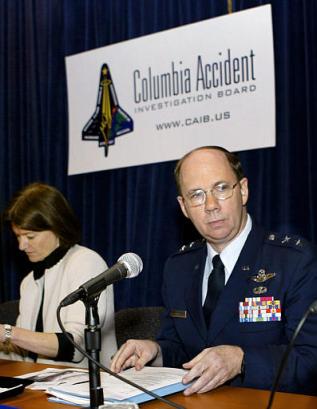Apparently, the falling of a lug from the external fuel tank 126 seconds after the launch and about 40 seconds after the foam fell, did not cause any damage, but it may cause damage in the following flights

Chairman of the Investigative Committee Harold Gehman, on Thursday in Washington
It is possible that the members of the investigative committee looking for the causes of the Columbia disaster have found a factor that may, unrelated to this disaster, cause other space shuttle disasters.
Members of the investigative committee said Thursday that a flaw in the shuttle's structure could cause the 18-kilogram lug to come loose and crash into the space shuttle during future launches. For comparison, the weight of the foam that hit Columbia and probably caused the panels or bolts to loosen was about one kilogram.
The component, which actually serves as a catch for the lugs that connect the solid fuel boosters and the external tank, can be easily reinforced and will not cause future problems when the shuttles take off again, experts say, but if this problematic equipment were not found, it would have the potential for future catastrophes," said committee member C Van Barry, senior officer in the US Air Force. "A component weighing about 18 kilograms that crashes into the wing of the shuttle will almost certainly cause damage to the spacecraft's heat shield, the officials said.
At the press conference, Barry said that investigators found radar evidence of an object drifting near Columbia moments after the solid fuel boosters had finished their part and separated from the outer canister during the January launch.
Barry said that during this phase of its flight, about 126 seconds after launch, engineers say there should be no debris near the spacecraft.
The researchers looking for a possible source of the figure seen on the radar determined that the object could be part of a 60 cm long heavy slider that connects the solid fuel boosters with the external fuel tank. The lug should explode in a manner ((((((((((((((((((((((((((severe, serious, aggravating, strict, restraining, sharp restraint, sharp piercing)))))))))))))))))))))) during the separation of the accelerator and the two parts should be caught by the same gripper.
Barry says that the Columbia lug catcher is made by a new manufacturer and has not undergone dynamic testing. When the committee members tested this component, it failed.
"The catcher is not as rigid as it should be," said committee chairman Harold Gehman. According to him, the lug catcher is supposed to withstand a load of 68 thousand inch-pounds, and in tests it failed with a load of only 56 thousand inch-pounds. Gehman said all of these failures occurred where these grippers are soldered. Now that the problem is known, committee member Scott Hubbard said the device can be fixed so it won't threaten the space shuttles in the future. Barry said there is no evidence that such a pod crashed into Columbia and committee members still adhere to the position that it was the foam that caused the crack in the wing that led to the disaster on landing.
Experiments last week with foam fragments thrown into a shuttle dummy wing demonstrated that the carbon fiber reinforcement panels on the wing can crack as a result of the collision. The experts, however, say that the experiments did not prove that the impact of the foam caused a crack large enough to cause the wing to fail during re-entry into the atmosphere.
The 13 members of the investigative committee moved to offices in Washington to begin writing the report. Gehman said that most of the stages of the investigation have already passed and groups of committee members who have received specific tasks have started writing chapters for the final report.
Gehman said that the goal is for the report to be submitted to Congress in August, but said that committee members were preparing to work more if necessary to "make the report correct."
In hearings held on Thursday, June 12, 2003, experts said that NASA's budget has been too thin for nearly a decade and it has had to save money from the shuttle program to pay for other programs. Commission staff are also investigating whether a lack of funding in the shuttle program caused safety compromises.
"The shuttle program was a cash cow, if you will, of funding the rest of NASA's wings," said John Longsdon, a member of the investigative committee and a professor at George Washington University.
